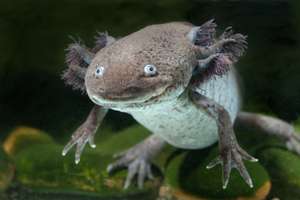The salamander king

When assistant professor of biology James Monaghan was an undergraduate, he hung a life-size inflatable Spiderman from the ceiling of his dorm room. The plastic incarnation of the superhero followed him all the way to his new lab here at Northeastern. His obsession with the "genius kid-scientist" earned Monaghan the nickname "Spiderman," and it stuck until graduate school, where he found a new obsession: salamanders.
Like the Lizard, the villain in the most recent Spiderman movie, Monaghan is a biologist interested in spinal cord and limb regeneration, for which salamanders have become known. In particular, Monaghan's research centers on the axolotl (AK'–suh–lot-l) salamander, which can regrow an arm, foot, or even parts of its brain in near-perfect fashion.
Monaghan analyzes the genomes of axolotls in an attempt to identify factors that are required for regeneration. If the same genes are present in humans but are simply not turned on during wound healing, he posits, then it is plausible to consider a future in which human limb regeneration is feasible.
While doing research as a postdoctoral student at the University of Florida, Monaghan and his colleagues published a one-of-a-kind paper in which they presented a genetically engineered salamander that glows green when its retinoic acid pathway is active. Retinoic acid is a signaling molecule that seems to be important for regeneration. By allowing labs to see retinoic acid activity, Monaghan's team created an important tool for the field.
Monaghan intends to continue developing similar tools in his research lab at Northeastern. "The next step is to generate animals that can express reporters and genes in specific tissues at specific times," he said.
The question of limb regeneration has puzzled scientists as far back as Aristotle. In 1768, one of the fathers of experimental biology, Lazzaro Spallanzani, wondered why other animals "are not endued with the same power" as salamanders. "Is it to be hoped they may acquire them by some useful disposition?" he asked. "Should the flattering expectation of obtaining this advantage for ourselves be considered entirely as chimerical?"
"[The quotation is] a great example of how many questions we ask in biology are not new, such as how animals develop or regenerate," said Monaghan, who suspects that the renaissance of regenerative biology in popular culture reflects the maturation of the field. "The exciting part is that we just now have the tools to properly address them."
Provided by Northeastern University




















